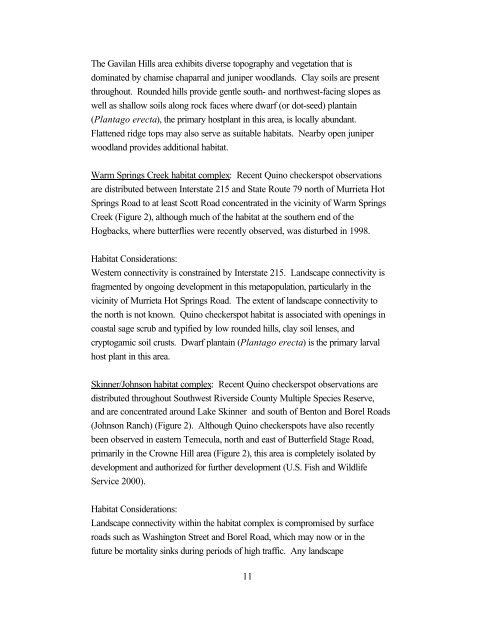Outline of Quino Recovery Plan - The Xerces Society
Outline of Quino Recovery Plan - The Xerces Society
Outline of Quino Recovery Plan - The Xerces Society
Create successful ePaper yourself
Turn your PDF publications into a flip-book with our unique Google optimized e-Paper software.
<strong>The</strong> Gavilan Hills area exhibits diverse topography and vegetation that is<br />
dominated by chamise chaparral and juniper woodlands. Clay soils are present<br />
throughout. Rounded hills provide gentle south- and northwest-facing slopes as<br />
well as shallow soils along rock faces where dwarf (or dot-seed) plantain<br />
(<strong>Plan</strong>tago erecta), the primary hostplant in this area, is locally abundant.<br />
Flattened ridge tops may also serve as suitable habitats. Nearby open juniper<br />
woodland provides additional habitat.<br />
Warm Springs Creek habitat complex: Recent <strong>Quino</strong> checkerspot observations<br />
are distributed between Interstate 215 and State Route 79 north <strong>of</strong> Murrieta Hot<br />
Springs Road to at least Scott Road concentrated in the vicinity <strong>of</strong> Warm Springs<br />
Creek (Figure 2), although much <strong>of</strong> the habitat at the southern end <strong>of</strong> the<br />
Hogbacks, where butterflies were recently observed, was disturbed in 1998.<br />
Habitat Considerations:<br />
Western connectivity is constrained by Interstate 215. Landscape connectivity is<br />
fragmented by ongoing development in this metapopulation, particularly in the<br />
vicinity <strong>of</strong> Murrieta Hot Springs Road. <strong>The</strong> extent <strong>of</strong> landscape connectivity to<br />
the north is not known. <strong>Quino</strong> checkerspot habitat is associated with openings in<br />
coastal sage scrub and typified by low rounded hills, clay soil lenses, and<br />
cryptogamic soil crusts. Dwarf plantain (<strong>Plan</strong>tago erecta) is the primary larval<br />
host plant in this area.<br />
Skinner/Johnson habitat complex: Recent <strong>Quino</strong> checkerspot observations are<br />
distributed throughout Southwest Riverside County Multiple Species Reserve,<br />
and are concentrated around Lake Skinner and south <strong>of</strong> Benton and Borel Roads<br />
(Johnson Ranch) (Figure 2). Although <strong>Quino</strong> checkerspots have also recently<br />
been observed in eastern Temecula, north and east <strong>of</strong> Butterfield Stage Road,<br />
primarily in the Crowne Hill area (Figure 2), this area is completely isolated by<br />
development and authorized for further development (U.S. Fish and Wildlife<br />
Service 2000).<br />
Habitat Considerations:<br />
Landscape connectivity within the habitat complex is compromised by surface<br />
roads such as Washington Street and Borel Road, which may now or in the<br />
future be mortality sinks during periods <strong>of</strong> high traffic. Any landscape<br />
11
















